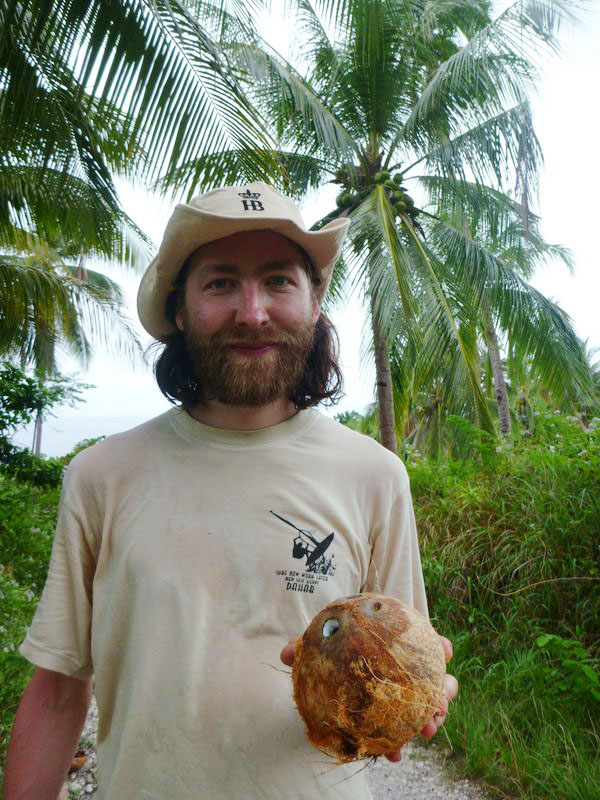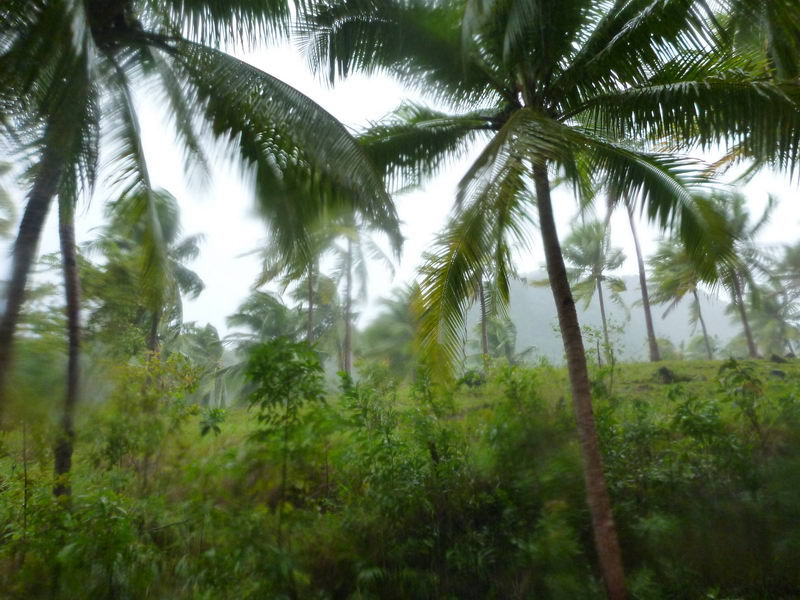In the morning, there were still no clouds in the sky, and in the hope that our friend was mistaken when he said that navigation was closed, we hurried to the village of Liloan, from which ferries go to Panglao Island. While we were on the bus, the sky was overcast, and even a light rain began to fall, but we did not observe anything unusual that could be a typhoon.
On the pier, near the small building of the marine station, people were already sitting on all sorts of bales and suitcases. We were already happy - since the local Filipinos are waiting here, it means there will be a ferry soon. After asking the workers, we found out that there would be a ferry, but we would have to wait a little, maybe three days…
Immediately, workers began to deploy awnings from the rain, bring chairs, in general, preparing for a long wait. The rain gradually intensified and after trampling for about an hour near the port, we decided that it would be better to return to our bamboo hut and hope that it would not be blown away by the wind.
When the water temperature at the ocean surface in tropical latitudes reaches twenty-six and a half degrees Celsius, the air above the ocean is saturated with moisture, and the complex process of forming a tropical cyclone begins, heated by the hot tropical sun.
Moist warm air rising up gradually cools down and gives off some of its moisture, which condenses and forms clouds. Continuing to rise to a height of 15 kilometers, the air cools, gradually giving up all its moisture and goes down again, where it heats up again and is saturated with moisture. And if the circumstances are successful, this process is increasingly accelerated and intensified. A system is formed that feeds itself. And the Coriolis effect, which arises due to the rotation of the Earth, gradually twists the updrafts and forms a spiral stream of air, which spins faster and faster, capturing ever larger volumes of air in its vortices.
In an area where heated air rises rapidly, an area of low pressure is formed, called a tropical depression. As the volume of air involved in the cycle increases, the wind speed and size of the cyclone increases, and it gradually turns into a storm, and then into a typhoon.
In the very center of the typhoon, the “eye of the cyclone” is formed, an area of circular shape and a diameter of up to 370 kilometers, with very low atmospheric pressure. Inside this area, dry air from the upper atmosphere descends to the surface of the earth, so the sky remains cloudless. The eye of the cyclone is surrounded by a ring of dense thunderstorm clouds up to 80 kilometers thick - the “wall of the eye”, it is here that the wind reaches a monstrous force of more than 80 meters per second, capable of uprooting trees and destroying buildings. Inside this area, all the moisture that has evaporated from the ocean is pouring out in showers. The amount of precipitation can reach one meter.
Around the eye of the typhoon and the wall of the eye, there are several more bands of dense thunderstorms that slowly move in a spiral and merge with the wall of the eye forming a giant spiral structure. Along the way, the typhoon creates tidal waves up to 6 meters high, which flood and wash away all coastal areas.
Under the influence of trade winds, which constantly blow from east to west, the typhoon moves, sowing chaos and destruction in its path.
The record number of victims of a tropical cyclone is considered to be Cyclone Bhola in 1970, which passed through the densely populated Ganges Delta and killed from 300 thousand to 500 thousand people, and the potential number of direct and indirect victims from this cyclone can reach one million…
Typhoon Nina struck China in 1975, as a result of flooding that washed away 62 dams, about 100 thousand residents died…
Hurricane Katrina in 2005 caused losses of more than $ 100 billion, the same hurricane led to the deaths of at least 1,836 people in Louisiana and Mississippi…
The number of Filipinos killed or missing as a result of the disaster on November 10, 2013, exceeded 8 thousand, the super typhoon completely destroyed or partially damaged 1.1 million homes, depriving 4 million people of housing…
Four types of signals have been developed for alerts, they differ in the designation of the time intervals after which a disaster is expected: 36, 24, 18 and 12 hours. The government's website lists meteorological conditions and precautions for each signal. For example, at the first signal, the wind can break branches and demolish light roofs, at the second it bends coconut palms and tears old galvanized iron from the roof, at the third it uproots trees and destroys houses made of light materials, at the fourth it destroys everything…
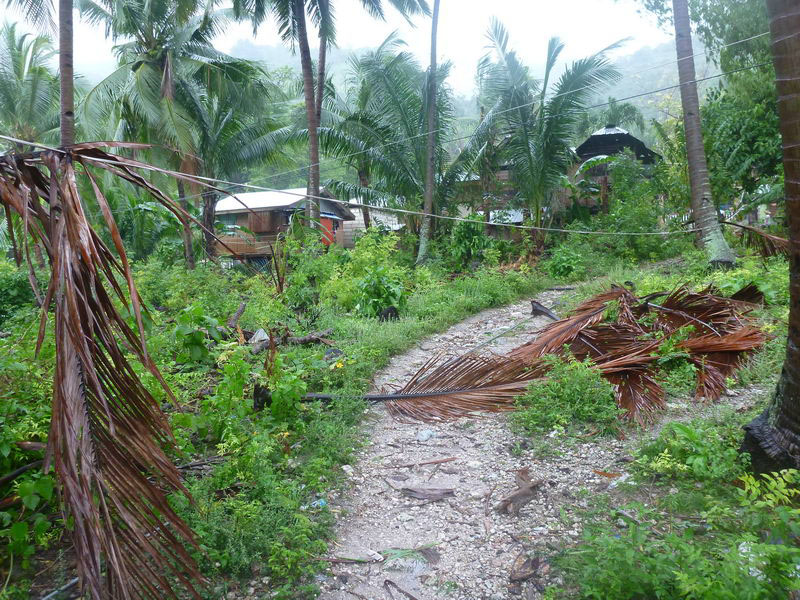
The wind violently shook the top of the palm tree behind the thin bamboo walls of our hut and we were worried that if a coconut suddenly fell on top of the roof, it would break a hole in the ceiling and then we would be flooded with water, which already starts dripping from the leaky roof in some places.
But the coconut still did not fall, and we decided to go for a walk in the coconut forest, where we had gutted the coconut we had found the day before. Surely the wind has knocked out a lot of new nuts there, and while all the local Filipinos are hiding at home, we collect a whole bag of coconuts.
A strong wind with gusts carried water dust over the ground, it did not even look like ordinary rain, there were no individual drops, there was just a continuous veil of fine spray. Palm trees swayed from side to side, but surprisingly did not break, apparently millions of years of evolution have selected the most resistant specimens.
Periodically, something fell noisily in the forest, we were already glad that this fresh batch of coconuts was ripe. The only thing left is to go into the forest and collect as many coconuts as we can carry. But how not to get a coconut on the head at the same time? Those who don't take risks don't eat coconuts, I thought, and boldly stepped into the jungle.
Everything was wet and slippery from the rain-I hope there are no poisonous snakes here.
After several minutes of searching, I did not find a single freshly fallen coconut. How is that so? After all, here they are, hanging on every tree around, why didn't the typhoon drop at least a couple for us? Well, if the coconut does not go to Mohammed, then you need to find a longer stick and poke up the mountain, or rather into the coconut.
And here is a suitable low palm tree, with coconuts, which, theoretically, can be reached with a long stick. A long bamboo stick was found right there in the bushes. But after a couple of minutes, nothing happened in trying to tear the coconut off the tree - the coconut was hanging in the same place, not wanting to fall down in any way. Well, how is that?
I slurped my way out of the jungle onto the high road, covered in dust from a bamboo stick, pieces of leaves and scratches from thorny bushes.
While we were thinking about what to do next, standing under the roof of some kind of awning that looked like a bus stop, a couple of local residents, indigenous Filipinos, passed by. They asked what we were doing here. Word for word, and we are already discussing where to find wild monkeys here in the forest, because it looks like the coconut that we found yesterday was plucked from a tree by some monkey, who then lost it, or maybe someone scared her off and she dropped the coconut in fright.
But according to the Filipinos, now all the wild monkeys are hiding somewhere in the forest because of the rain and it will be difficult to find them. But, they know a place nearby where a man caught a monkey, chained it up and tamed it. And now we are walking along a narrow path among the jungle.
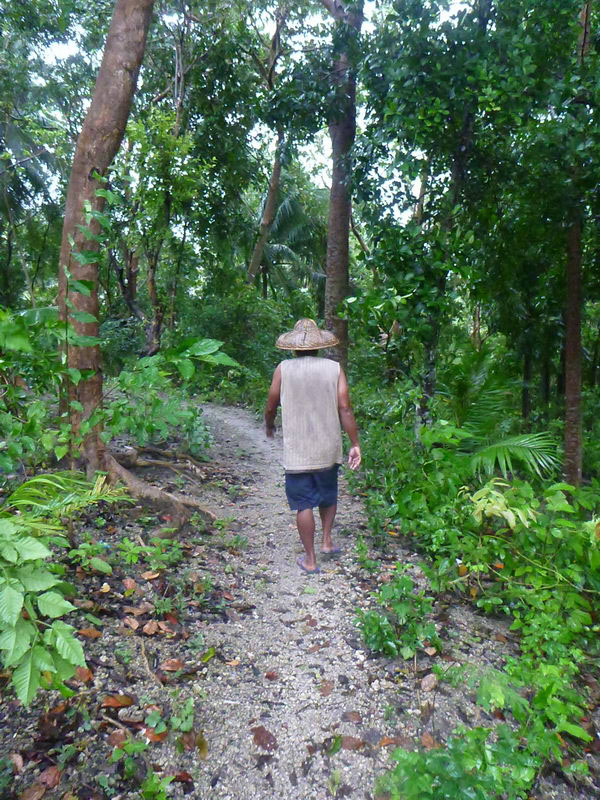
I had never seen such dense thickets before, all the trees were covered with vines, and it was not possible to step aside from the path for at least a meter, let alone try to walk through these thickets. So we walked for about ten minutes and suddenly came out into some kind of village consisting of several huts. Banana bushes grew around the houses, papayas that had not yet ripened hung on bald sticks without leaves, and in one place there was a whole plantation of mangoes, but, unfortunately, they were also still green, and of course palm trees with coconuts everywhere.
Behind one of the houses, a wooden crossbar was fixed between two palm trees, on which this monkey was sitting. She was chained to a tree by her tail, and couldn't get far from those trees and the crossbar.
The monkey, apparently, was not very happy that she had to sit here on a chain, because she hissed angrily at everyone and made terrible grimaces.
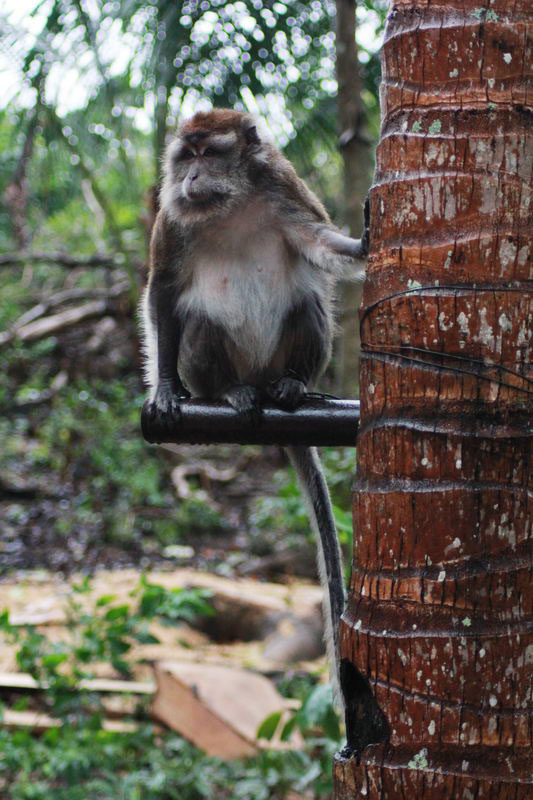
Having marveled a little at such a curiosity, because we had never seen an almost wild monkey before, we were accompanied by local residents to the nearest road. After all, it's also interesting - do they, in the sense of locals, have no more important things to do than meeting a couple of tourists in the forest, cross the jungle with them to look at some kind of macaque? And all this is still in the rain…
After watching the monkey, on the way back to the house, we once again turned into the jungle and still collected a full backpack of coconuts, it is not clear why we need them in such quantity, and even though they look like they have not only fallen, but have been lying there for a long time, but do not leave them They just rot there…
This time, the cleaning process was faster, we had already learned how to tear off the upper fibrous skin quite quickly, and took the nut itself with us.
Then, when we gutted the nuts ourselves, we noticed that the juice inside was completely different in taste, and even felt like it was greasy. And when we poured it into a mug, there were really greasy streaks on the surface.
And there was also a round thing the size of a cherry inside the nut itself, I don't remember what we did with it anymore, but we probably tried it edible or not.
We put all the coconuts in the corner of our hut, and the next morning it turned out that local ants had found out about this pile, and there was already a whole highway along which these ants scurried back and forth carrying pieces of food somewhere through the leaky walls. We had to get rid of the supplies urgently so that these ants would not devour us at the same time.
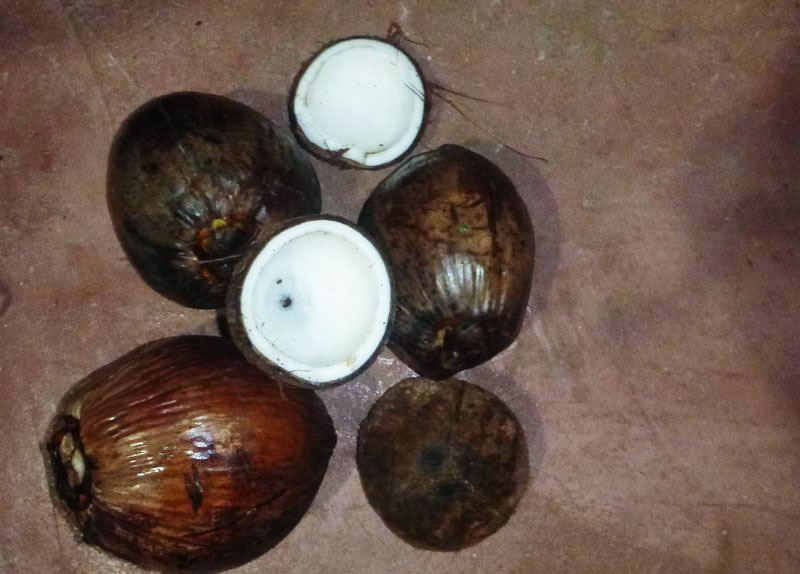
But Olya managed to observe early in the morning what the workers from shark bathing were doing while going to sea was prohibited due to the typhoon and there were no tourists.
The Philippines has its own national sport, which is very popular here - cockfighting or Sabong in Filipino. I will try to write a separate story about sabong, if I don't forget. In the Philippines, it is very common to meet people who go somewhere with a rooster or several - by bus, on a moped or by plane. Some companies even provide special boxes with a handle like a suitcase and holes for ventilation where you can put your fighting cock and fly with it in the cabin. Sometimes there is even a special hole so that the rooster can stick his head out and keep a close eye on everyone around, looking for a suitable victim.
Once, when I was little, in the summer my mother and I went to the Crimea, to the sea. On the way to the beach, we passed through a street with private houses, near which all sorts of chickens, geese and other animals were running. And then one day, passing by such a flock, a huge rooster suddenly rushed at me, or at least it seemed huge to me - it barely fought off and ran away. And despite the fact that we don't train them specifically for cockfighting, otherwise he could have killed me... Although maybe there was some fugitive Filipino living in Crimea who illegally sailed on a homemade pie?
So, while I was still sleeping, Olya had time for a cockfight, and by the time I got out of bed, it was all over and the defeated rooster was carried away in the direction of the kitchen.
And at breakfast, we were delighted with the news that navigation seems to have been opened. But the ferries are not running yet, but there will be a boat that will take all interested tourists, just to the island where we need to go. No one knows when it will be, or maybe it won't be at all, but it's better not to go far, in case the boat does appear.
The tropical depression has passed, and there is hope that we will have time to move to the right island this year.
